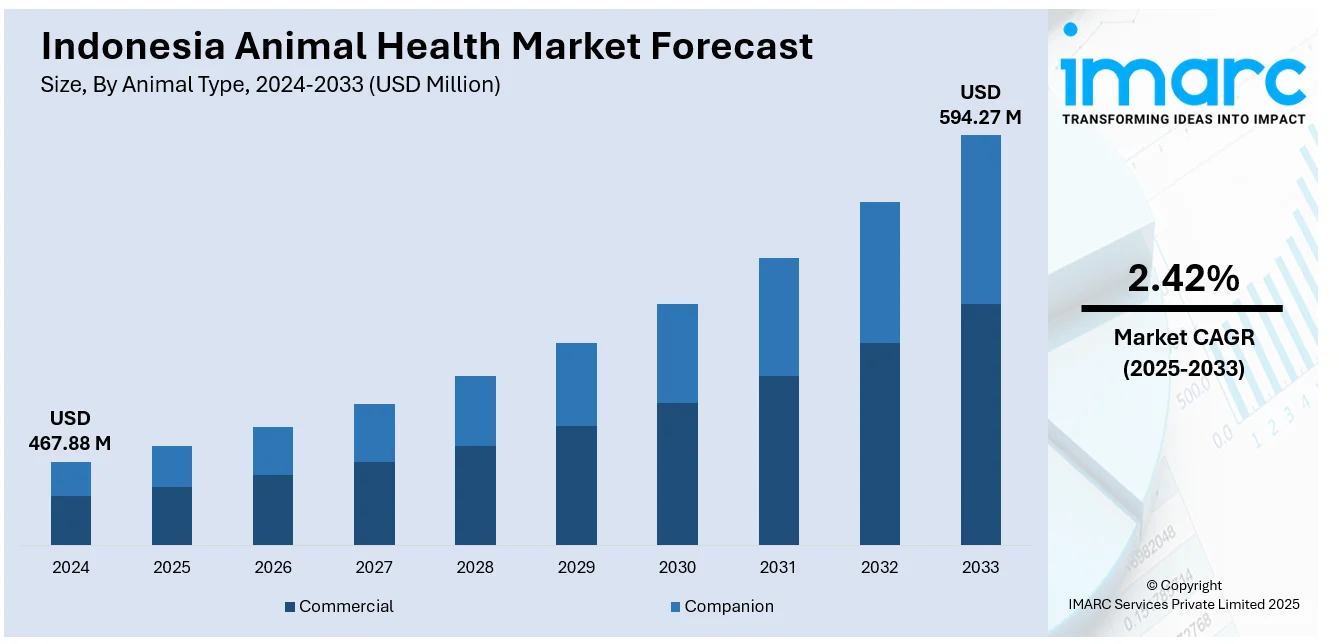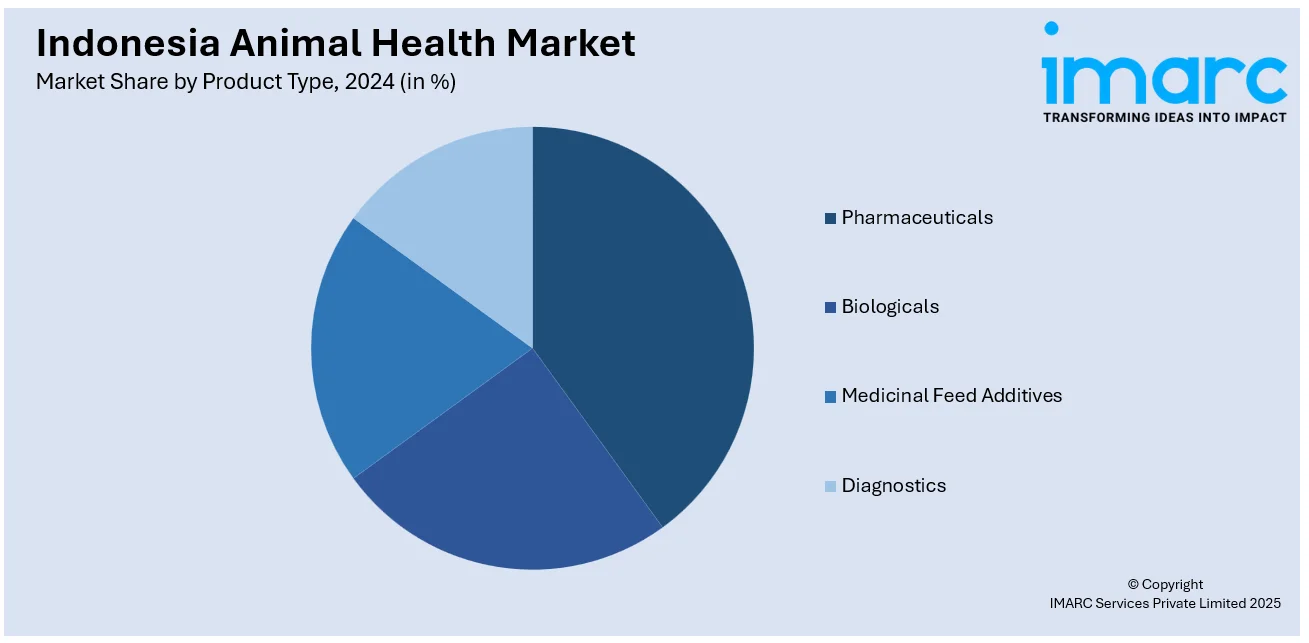
Indonesia Animal Health Market Size, Share, Trends and Forecast by Animal Type, Product Type, and Region, 2025-2033
Indonesia Animal Health Market Overview:
The Indonesia animal health market size reached USD 467.88 Million in 2024. Looking forward, IMARC Group expects the market to reach USD 594.27 Million by 2033, exhibiting a growth rate (CAGR) of 2.42% during 2025-2033. At present, the demand for animal products like meat, milk, and eggs is contributing significantly to the market growth. Moreover, the Indonesian government is actively implementing regulations and initiatives aimed at upgrading the animal health standards, which is supporting the market growth. Apart from this, the increasing awareness about the value of animal health and prevention of disease among farmers is expanding the Indonesia animal health market share.
|
Report Attribute
|
Key Statistics
|
|---|---|
|
Base Year
|
2024 |
|
Forecast Years
|
2025-2033
|
|
Historical Years
|
2019-2024
|
| Market Size in 2024 | USD 467.88 Million |
| Market Forecast in 2033 | USD 594.27 Million |
| Market Growth Rate 2025-2033 | 2.42% |
Indonesia Animal Health Market Trends:
Increased awareness of Animal Health and Prevention of Disease
The rising awareness about the value of animal health and prevention of disease among Indonesian farmers is having a strong impact on the market. Education campaigns and government initiatives are helping to create increased awareness of the effects of animal health being neglected, such as outbreaks of diseases that may impact food supply and quality. Consequently, farmers are looking for solutions to prevent and control diseases, resorting to veterinary services and animal health products to guarantee improved animal care. This move toward proactive health care is spurring the consumption of vaccines, supplements, and diagnostic equipment. There is also increased emphasis on applying biosecurity practices to avoid zoonotic diseases, which further drives the demand for animal health products. The focus on disease prevention and animal welfare improvement is developing a favorable market setting.

To get more information on this market, Request Sample
Government Regulations and Initiatives
The Indonesian government is actively implementing regulations and initiatives aimed at upgrading the animal health standards, which is supporting the Indonesia animal health market growth. By implementing tougher laws on animal disease control, the government is keeping animal health at the forefront. In 2025, the Ministry of Agriculture's Directorate General of Livestock and Animal Health is encouraging greater investment and the embrace of technological innovations to sustainably boost the competitiveness of Indonesia's livestock sector. The regulations are driving farmers to embrace high-tech veterinary practices and spend money on animal health products, including vaccines and medicines for preventing disease. The government's growing emphasis on food safety and quality is also driving the demand for products that prevent livestock disease and improve overall health in animals. Through their application, veterinary care is being incorporated into the general agricultural industry, fueling the growth of the sector. These constant efforts are raising awareness about animal health measures to the advantage of both the agricultural sector and consumers in Indonesia.
Surging Demand for Animal Protein
Rising demand for animal products like meat, milk, and eggs is highly contributing to the market growth. With the rising population and incomes, individuals are increasingly opting for high-protein diets, especially those from livestock. The rising demand is encouraging farmers and cattle raisers to enhance the productivity and health of their animals. As a result, there is a rise in the use of veterinary products like vaccines, antibiotics, and supplements in order to maintain the health of livestock. This is propelling the Indonesia animal health market growth as animal health products are becoming critical to having a consistent supply of safe and high-quality animal protein. Meanwhile, the Indonesian government and the agricultural industry are also concentrating on enhancing the livestock market to cope with this increasing demand, further driving the animal health sector. Farmers are also investing in good-quality animal feed to maintain the proper health of animals. The IMARC Group predicts that the Indonesia animal feed market is projected to reach USD 12.5 Billion by 2033.
Indonesia Animal Health Market Segmentation:
IMARC Group provides an analysis of the key trends in each segment of the market, along with forecasts at the country and regional levels for 2025-2033. Our report has categorized the market based on animal type and product type.
Animal Type Insights:
- Commercial
- Companion
The report has provided a detailed breakup and analysis of the market based on the animal type. This includes commercial and companion.
Product Type Insights:

- Pharmaceuticals
- Biologicals
- Medicinal Feed Additives
- Diagnostics
A detailed breakup and analysis of the market based on the product type have also been provided in the report. This includes pharmaceuticals, biologicals, medicinal feed additives, and diagnostics.
Regional Insights:
- Java
- Sumatra
- Kalimantan
- Sulawesi
- Others
The report has also provided a comprehensive analysis of all the major regional markets, which include Java, Sumatra, Kalimantan, Sulawesi, and others.
Competitive Landscape:
The market research report has also provided a comprehensive analysis of the competitive landscape. Competitive analysis such as market structure, key player positioning, top winning strategies, competitive dashboard, and company evaluation quadrant has been covered in the report. Also, detailed profiles of all major companies have been provided.
Indonesia Animal Health Market Report Coverage:
| Report Features | Details |
|---|---|
| Base Year of the Analysis | 2024 |
| Historical Period | 2019-2024 |
| Forecast Period | 2025-2033 |
| Units | Million USD |
| Scope of the Report |
Exploration of Historical Trends and Market Outlook, Industry Catalysts and Challenges, Segment-Wise Historical and Future Market Assessment:
|
| Animal Types Covered | Commercial, Companion |
| Product Types Covered | Pharmaceuticals, Biologicals, Medicinal Feed Additives, Diagnostics |
| Regions Covered | Java, Sumatra, Kalimantan, Sulawesi, Others |
| Customization Scope | 10% Free Customization |
| Post-Sale Analyst Support | 10-12 Weeks |
| Delivery Format | PDF and Excel through Email (We can also provide the editable version of the report in PPT/Word format on special request) |
Key Questions Answered in This Report:
- How has the Indonesia animal health market performed so far and how will it perform in the coming years?
- What is the breakup of the Indonesia animal health market on the basis of animal type?
- What is the breakup of the Indonesia animal health market on the basis of product type?
- What is the breakup of the Indonesia animal health market on the basis of region?
- What are the various stages in the value chain of the Indonesia animal health market?
- What are the key driving factors and challenges in the Indonesia animal health market?
- What is the structure of the Indonesia animal health market and who are the key players?
- What is the degree of competition in the Indonesia animal health market?
Key Benefits for Stakeholders:
- IMARC’s industry report offers a comprehensive quantitative analysis of various market segments, historical and current market trends, market forecasts, and dynamics of the Indonesia animal health market from 2019-2033.
- The research report provides the latest information on the market drivers, challenges, and opportunities in the Indonesia animal health market.
- Porter's five forces analysis assist stakeholders in assessing the impact of new entrants, competitive rivalry, supplier power, buyer power, and the threat of substitution. It helps stakeholders to analyze the level of competition within the Indonesia animal health industry and its attractiveness.
- Competitive landscape allows stakeholders to understand their competitive environment and provides an insight into the current positions of key players in the market.
Need more help?
- Speak to our experienced analysts for insights on the current market scenarios.
- Include additional segments and countries to customize the report as per your requirement.
- Gain an unparalleled competitive advantage in your domain by understanding how to utilize the report and positively impacting your operations and revenue.
- For further assistance, please connect with our analysts.
 Request Customization
Request Customization
 Speak to an Analyst
Speak to an Analyst
 Request Brochure
Request Brochure
 Inquire Before Buying
Inquire Before Buying




.webp)




.webp)












